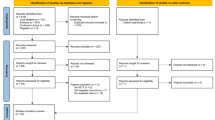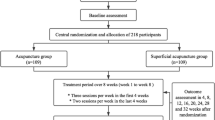Abstract
Background
Acupuncture has been shown to reduce tension-type headache (TTH) frequency in previous studies. Nevertheless, repeated significance testing might inflate type I error. We aimed to verify the effectiveness and safety of acupuncture in reducing TTH frequency by meta-analysis and trial sequential analysis (TSA).
Methods
Ovid Medline, Embase, and Cochrane Library were searched until September 29, 2022. Randomized controlled trials comparing acupuncture with sham acupuncture, no acupuncture, or other active therapies in adults with TTH were included. The primary outcome was TTH frequency. The secondary outcomes were responder rate and adverse event.
Results
Fourteen studies involving 2795 participants were included. Acupuncture had more reduction than sham acupuncture in TTH frequency, both after treatment (standardized mean difference [SMD] − 0.80, 95% CI − 1.36 to − 0.24, P = 0.005) and at the follow-up period (SMD − 1.33, 95% CI − 2.18 to − 0.49, P = 0.002), while TSA showed the included sample size did not exceed required information size (RIS). Acupuncture was superior over no acupuncture after treatment (SMD − 0.52, 95% CI − 0.63 to − 0.41, P < 0.001), and cumulative sample size reached RIS. In terms of responder rate, acupuncture had a higher responder rate compared with sham acupuncture both after treatment (relative ratio [RR] 1.28, 95% CI 1.12 to 1.46, P = 0.0003) and the follow-up period (RR 1.37, 95% CI 1.19 to 1.58, P < 0.0001), but the sample size is inadequate.
Conclusion
Acupuncture is an efficacious and safe treatment for TTH prevention, but this conclusion might be limited by the generally very low to low quality evidence. TSA suggested that high-quality trials are needed to verify the efficacy and safety of acupuncture compared to sham acupuncture.




Similar content being viewed by others
Data availability statement
The data that supports our study are shown in the article and supplementary material, further inquiries can be directed to the corresponding author.
References
GBD 2019 Diseases and Injuries Collaborators (2020) Global burden of 369 diseases and injuries in 204 countries and territories, 1990–2019: a systematic analysis for the Global Burden of Disease Study 2019. Lancet 396:1204–1222. https://doi.org/10.1016/S0140-6736(20)30925-9
GBD 2017 US Neurological Disorders Collaborators, Feigin VL, Vos T et al (2021) Burden of neurological disorders across the US from 1990–2017: A Global Burden of Disease Study. JAMA Neurol 78:165–176. https://doi.org/10.1001/jamaneurol.2020.4152
Ashina S, Mitsikostas DD, Lee MJ et al (2021) Tension-type headache. Nat Rev Dis Primers 7:24. https://doi.org/10.1038/s41572-021-00257-2
Headache Classification Committee of the International Headache Society (IHS) The International Classification of Headache Disorders, 3rd edn. Cephalalgia. 2018;38:1–211. https://doi.org/10.1177/0333102417738202
Stovner LJ, Hagen K, Linde M, Steiner TJ (2022) The global prevalence of headache: an update, with analysis of the influences of methodological factors on prevalence estimates. J Headache Pain 23:34. https://doi.org/10.1186/s10194-022-01402-2
GBD 2015 Disease and Injury Incidence and Prevalence Collaborators (2016) Global, regional, and national incidence, prevalence, and years lived with disability for 310 diseases and injuries, 1990–2015: a systematic analysis for the Global Burden of Disease Study 2015. Lancet 388:1545–1602. https://doi.org/10.1016/S0140-6736(16)31678-6
Andlin-Sobocki P, Jönsson B, Wittchen H-U, Olesen J (2005) Cost of disorders of the brain in Europe. Eur J Neurol 12(Suppl 1):1–27. https://doi.org/10.1111/j.1468-1331.2005.01202.x
Cassidy EM, Tomkins E, Hardiman O, O’Keane V (2003) Factors associated with burden of primary headache in a specialty clinic. Headache 43:638–644. https://doi.org/10.1046/j.1526-4610.2003.03106.x
Bigal ME, Bigal JM, Betti M et al (2001) Evaluation of the impact of migraine and episodic tension-type headache on the quality of life and performance of a university student population. Headache 41:710–719. https://doi.org/10.1046/j.1526-4610.2001.041007710.x
Robbins MS (2021) Diagnosis and management of headache: a review. JAMA 325:1874–1885. https://doi.org/10.1001/jama.2021.1640
Bendtsen L, Evers S, Linde M et al (2010) EFNS guideline on the treatment of tension-type headache—report of an EFNS task force. Eur J Neurol 17:1318–1325. https://doi.org/10.1111/j.1468-1331.2010.03070.x
Bendtsen L, Jensen R (2004) Mirtazapine is effective in the prophylactic treatment of chronic tension-type headache. Neurology 62:1706–1711. https://doi.org/10.1212/01.wnl.0000127282.90920.8c
Fernando Prieto Peres M, Prieto Peres Mercante J, Belitardo de Oliveira A (2019) Non-pharmacological treatment for primary headaches prevention and lifestyle changes in a low-income community of Brazil: a randomized clinical trial. Headache 59:86–96. https://doi.org/10.1111/head.13457
Martin PR, Forsyth MR, Reece J (2007) Cognitive-behavioral therapy versus temporal pulse amplitude biofeedback training for recurrent headache. Behav Ther 38:350–363. https://doi.org/10.1016/j.beth.2006.10.004
Melchart D, Streng A, Hoppe A et al (2005) Acupuncture in patients with tension-type headache: randomised controlled trial. BMJ (Clinical research ed) 331:376–382. https://doi.org/10.1136/bmj.38512.405440.8F
Zheng H, Gao T, Zheng Q-H et al (2022) Acupuncture for patients with chronic tension-type headache: a randomized controlled trial. Neurology. https://doi.org/10.1212/WNL.0000000000200670
Jena S, Witt C, Brinkhaus B et al (2008) Acupuncture in patients with headache. Cephalalgia 28:969–979. https://doi.org/10.1111/j.1468-2982.2008.01640.x
Linde K, Allais G, Brinkhaus B et al (2016) Acupuncture for the prevention of tension-type headache. Cochrane Database Syst Rev 4:CD007587. https://doi.org/10.1002/14651858.CD007587.pub2
Linde K, Allais G, Brinkhaus B, et al (2009) Acupuncture for tension-type headache. Cochrane Database Syst Rev CD007587. https://doi.org/10.1002/14651858.CD007587
Pi C, Liu Y, Li L et al (2022) Effects on neuromodulation, acupuncture, and aerobic exercises on migraine and tension-type headache outcomes: a systematic review and meta-analysis. Medicine (Baltimore) 101:e30530. https://doi.org/10.1097/MD.0000000000030530
Borm GF, Donders ART (2009) Updating meta-analyses leads to larger type I errors than publication bias. J Clin Epidemiol 62:825-830.e10. https://doi.org/10.1016/j.jclinepi.2008.08.010
Wetterslev J, Thorlund K, Brok J, Gluud C (2008) Trial sequential analysis may establish when firm evidence is reached in cumulative meta-analysis. J Clin Epidemiol 61:64–75. https://doi.org/10.1016/j.jclinepi.2007.03.013
Shah A, Smith AF (2020) Trial sequential analysis: adding a new dimension to meta-analysis. Anaesthesia 75:15–20. https://doi.org/10.1111/anae.14705
Pogue JM, Yusuf S (1997) Cumulating evidence from randomized trials: utilizing sequential monitoring boundaries for cumulative meta-analysis. Control Clin Trials 18:580–593. https://doi.org/10.1016/s0197-2456(97)00051-2. (discussion 661-666)
Thorlund K, Devereaux PJ, Wetterslev J et al (2009) Can trial sequential monitoring boundaries reduce spurious inferences from meta-analyses? Int J Epidemiol 38:276–286. https://doi.org/10.1093/ije/dyn179
Page MJ, McKenzie JE, Bossuyt PM et al (2021) The PRISMA 2020 statement: an updated guideline for reporting systematic reviews. BMJ 372:n71. https://doi.org/10.1136/bmj.n71
Sterne JAC, Savović J, Page MJ et al (2019) RoB 2: a revised tool for assessing risk of bias in randomised trials. BMJ 366:l4898. https://doi.org/10.1136/bmj.l4898
Higgins JPT, Thompson SG, Deeks JJ, Altman DG (2003) Measuring inconsistency in meta-analyses. BMJ 327:557–560. https://doi.org/10.1136/bmj.327.7414.557
Guyatt GH, Oxman AD, Vist GE et al (2008) GRADE: an emerging consensus on rating quality of evidence and strength of recommendations. BMJ 336:924–926. https://doi.org/10.1136/bmj.39489.470347.AD
Ebneshahidi NS, Heshmatipour M, Moghaddami A, Eghtesadi-Araghi P (2005) The effects of laser acupuncture on chronic tension headache—a randomised controlled trial. Acupunct Med 23:13–18. https://doi.org/10.1136/aim.23.1.13
Endres HG, Böwing G, Diener H-C et al (2007) Acupuncture for tension-type headache: a multicentre, sham-controlled, patient-and observer-blinded, randomised trial. J Headache Pain 8:306–314. https://doi.org/10.1007/s10194-007-0416-5
Gildir S, Tuzun EH, Eroglu G, Eker L (2019) A randomized trial of trigger point dry needling versus sham needling for chronic tension-type headache. Medicine (Baltimore) 98:e14520. https://doi.org/10.1097/MD.0000000000014520
Karst M, Reinhard M, Thum P et al (2001) Needle acupuncture in tension-type headache: a randomized, placebo-controlled study. Cephalalgia 21:637–642. https://doi.org/10.1046/j.1468-2982.2001.00198.x
Kwak B, Kim M, Kim Y et al (2008) Persisting effects of acupuncture method for chronic tension-type headache; a randomized controlled trial. Journal of Korean Acupuncture & Moxibustion Society [taehan chimgu hakhoe chi] 25:165–177
Schiller J, Karst M, Kellner T et al (2021) Combination of acupuncture and medical training therapy on tension type headache: results of a randomised controlled pilot study. Cephalalgia 41:879–893. https://doi.org/10.1177/0333102421989620
Söderberg E, Carlsson J, Stener-Victorin E (2006) Chronic tension-type headache treated with acupuncture, physical training and relaxation training. Between-group differences. Cephalalgia 26:1320–1329. https://doi.org/10.1111/j.1468-2982.2006.01209.x
Tavola T, Gala C, Conte G, Invernizzi G (1992) Traditional Chinese acupuncture in tension-type headache: a controlled study. Pain 48:325–329. https://doi.org/10.1016/0304-3959(92)90080-U
Wang K, Svensson P, Arendt-Nielsen L (2007) Effect of acupuncture-like electrical stimulation on chronic tension-type headache: a randomized, double-blinded, placebo-controlled trial. Clin J Pain 23:316–322. https://doi.org/10.1097/AJP.0b013e318030c904
White AR, Resch K-L, Chan JCK et al (2000) Acupuncture for episodic tension-type headache: a multicentre randomized controlled trial. Cephalalgia 20:632–637. https://doi.org/10.1046/j.1468-2982.2000.00097.x
Xue CCL, Dong L, Polus B et al (2004) Electroacupuncture for tension-type headache on distal acupoints only: a randomized, controlled, crossover trial. Headache 44:333–341. https://doi.org/10.1111/j.1526-4610.2004.04077.x
Bot MN, de Wijer A, Pool J et al (2020) Physical treatments reduce pain in children with tension-type headache: a systematic review and meta-analysis. J Oral Facial Pain Headache 34:240–254. https://doi.org/10.11607/ofph.2575
Zhang J, Zhang Z, Huang S et al (2022) Acupuncture for cancer-related insomnia: a systematic review and meta-analysis. Phytomedicine 102:154160. https://doi.org/10.1016/j.phymed.2022.154160
Li M, Niu J, Yan P et al (2020) The effectiveness and safety of acupuncture for depression: an overview of meta-analyses. Complement Ther Med 50:102202. https://doi.org/10.1016/j.ctim.2019.102202
Meissner K, Fässler M, Rücker G et al (2013) Differential effectiveness of placebo treatments: a systematic review of migraine prophylaxis. JAMA Intern Med 173:1941–1951. https://doi.org/10.1001/jamainternmed.2013.10391
Fan S-Q, Jin S, Tang T-C et al (2021) Efficacy of acupuncture for migraine prophylaxis: a trial sequential meta-analysis. J Neurol 268:4128–4137. https://doi.org/10.1007/s00415-020-10178-x
Tian H, Huang L, Sun M et al (2022) Acupuncture for knee osteoarthritis: a systematic review of randomized clinical trials with meta-analyses and trial sequential analyses. Biomed Res Int 2022:6561633. https://doi.org/10.1155/2022/6561633
Lin X, Huang K, Zhu G et al (2016) The effects of acupuncture on chronic knee pain due to osteoarthritis: a meta-analysis. J Bone Joint Surg Am 98:1578–1585. https://doi.org/10.2106/JBJS.15.00620
Lu L, Zhang Y, Tang X et al (2022) Evidence on acupuncture therapies is underused in clinical practice and health policy. BMJ 376:e067475. https://doi.org/10.1136/bmj-2021-067475
Mu J, Furlan AD, Lam WY et al (2020) Acupuncture for chronic nonspecific low back pain. Cochrane Database Syst Rev 12:CD013814. https://doi.org/10.1002/14651858.CD013814
McGeeney BE (2015) Acupuncture is all placebo and here is why. Headache 55:465–469. https://doi.org/10.1111/head.12524
Funding
HZ received a grant from the Sichuan Youth Science and Technology Innovation Research Team (No.2021JDTD0007). YZ-S received a grant from National Natural Science Foundation of China Youth Project (No. 82105026). YZ-S also received a grant from China Postdoctoral Science Foundation (No. 2021M693787). Role of the funding source: These sponsors did not participate in the study design; the collection, analysis, and interpretation of data; the writing of the manuscript; and the decision to submit the article for publication.
Author information
Authors and Affiliations
Contributions
QF-T: study selection, analyzed and interpreted the data, drafted the manuscript for intellectual content. XY-W: study selection, data extraction, quality assessment, critical revision of the manuscript for important intellectual content. SJ-F: data extraction, quality assessment, critical revision of the manuscript for important intellectual content. XY-X, YZ-S, CR-X: critical revision of the manuscript for important intellectual content. HZ: study design and conceptualization, critical revision of the manuscript for important intellectual content. All authors had full access to all the data in the study and take responsibility for the integrity of the data and the accuracy of the data analysis. All authors have also agreed to submit for publication.
Corresponding author
Ethics declarations
Conflicts of interest
The authors declare that they have no conflict of interest.
Ethical standards
Our study was a systematic review and meta-analysis with trial sequential analysis of published researches and was exempt from review and approval by the research ethics committee.
Supplementary Information
Below is the link to the electronic supplementary material.
Rights and permissions
Springer Nature or its licensor (e.g. a society or other partner) holds exclusive rights to this article under a publishing agreement with the author(s) or other rightsholder(s); author self-archiving of the accepted manuscript version of this article is solely governed by the terms of such publishing agreement and applicable law.
About this article
Cite this article
Tao, QF., Wang, XY., Feng, SJ. et al. Efficacy of acupuncture for tension-type headache prophylaxis: systematic review and meta-analysis with trial sequential analysis. J Neurol 270, 3402–3412 (2023). https://doi.org/10.1007/s00415-023-11695-1
Received:
Revised:
Accepted:
Published:
Issue Date:
DOI: https://doi.org/10.1007/s00415-023-11695-1




